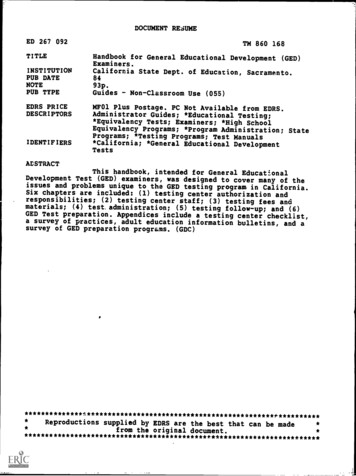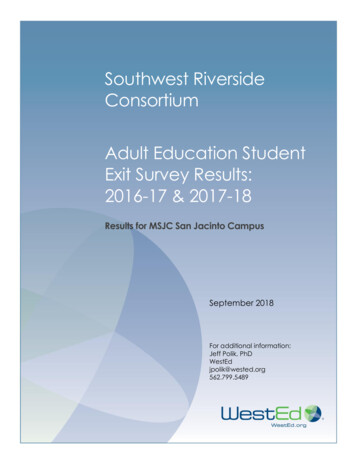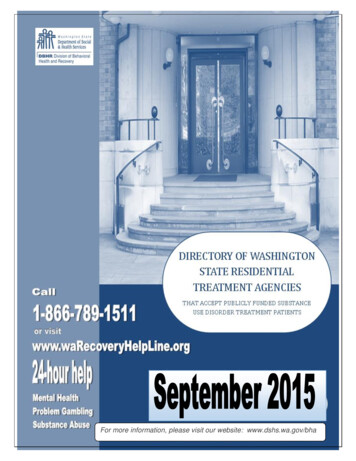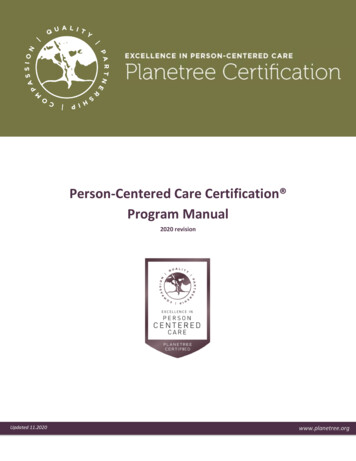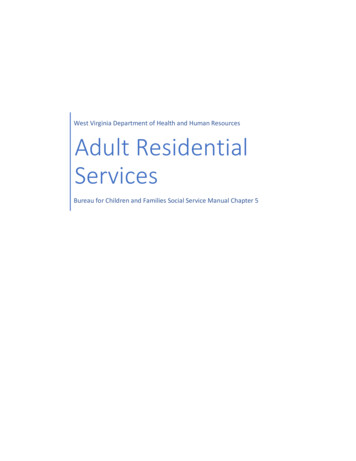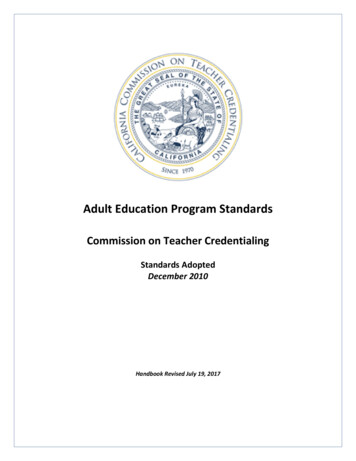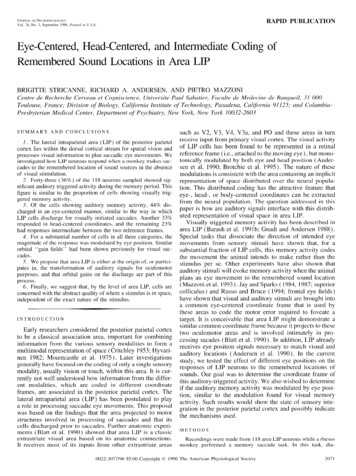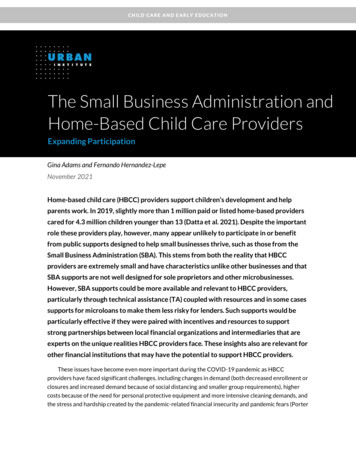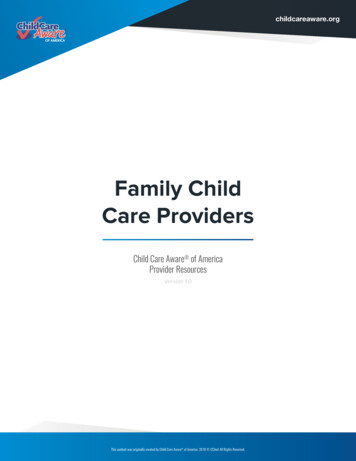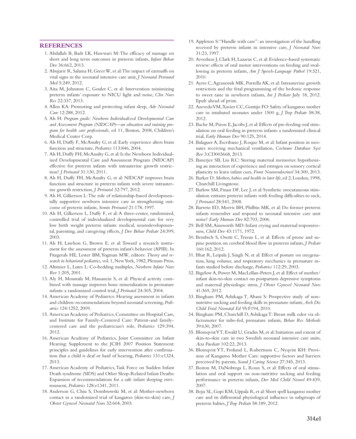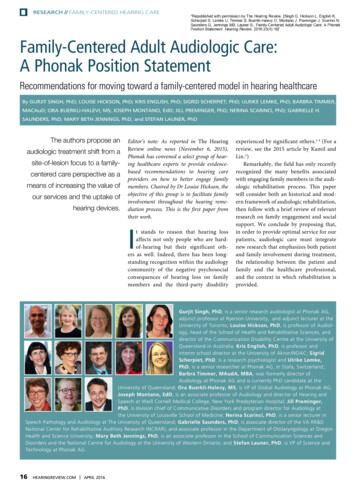
Transcription
Research // Family-Centered Hearing careFamily-Centered Adult Audiologic Care:A Phonak Position StatementRecommendations for moving toward a family-centered model in hearing healthcareBy Gurjit Singh, PhD; Louise Hickson, PhD; Kris English, PhD; Sigrid Scherpiet, PhD; Ulrike Lemke, PhD; Barbra Timmer,MACAuD; Ora Buerkli-Halevi, MS; Joseph Montano, EdD; Jill Preminger, PhD; Nerina Scarinci, PhD; Gabrielle H.Saunders, PhD; Mary Beth Jennings, PhD, and Stefan Launer, PhDThe authors propose anaudiologic treatment shift from asite-of-lesion focus to a familycentered care perspective as ameans of increasing the value ofour services and the uptake ofhearing devices.Editor’s note: As reported in The HearingReview online news (November 6, 2015),Phonak has convened a select group of hearing healthcare experts to provide evidencebased recommendations to hearing careproviders on how to better engage familymembers. Chaired by Dr Louise Hickson, theobjective of this group is to facilitate familyinvolvement throughout the hearing remediation process. This is the first paper fromtheir work.It stands to reason that hearing lossaffects not only people who are hardof-hearing but their significant others as well. Indeed, there has been longstanding recognition within the audiologycommunity of the negative psychosocialconsequences of hearing loss on familymembers and the third-party disabilityexperienced by significant others.1-4 (For areview, see the 2015 article by Kamil andLin.5)Remarkably, the field has only recentlyrecognized the many benefits associatedwith engaging family members in the audiologic rehabilitation process. This paperwill consider both an historical and modern framework of audiologic rehabilitation,then follow with a brief review of relevantresearch on family engagement and socialsupport. We conclude by proposing that,in order to provide optimal service for ourpatients, audiologic care must integratenew research that emphasizes both patientand family involvement during treatment,the relationship between the patient andfamily and the healthcare professional,and the context in which rehabilitation isprovided.Gurjit Singh, PhD, is a senior research audiologist at Phonak AG,adjunct professor at Ryerson University, and adjunct lecturer at theUniversity of Toronto; Louise Hickson, PhD, is professor of Audiology, head of the School of Health and Rehabilitative Sciences, anddirector of the Communication Disability Centre at the University ofQueensland in Australia; Kris English, PhD, is professor andinterim school director at the University of Akron/NOAC; SigridScherpiet, PhD, is a research psychologist and Ulrike Lemke,PhD, is a senior researcher at Phonak AG, in Stafa, Switzerland;Barbra Timmer, MAudA, MBA, was formerly director ofAudiology at Phonak AG and is currently PhD candidate at theUniversity of Queensland; Ora Buerkli-Halevy, MS, is VP of Global Audiology at Phonak AG;Joseph Montano, EdD, is an associate professor of Audiology and director of Hearing andSpeech at Weill Cornell Medical College, New York Presbyterian Hospital; Jill Preminger,PhD, is division chief of Communicative Disorders and program director for Audiology atthe University of Louisville School of Medicine; Nerina Scarinci, PhD, is a senior lecturer inSpeech Pathology and Audiology at The University of Queensland; Gabrielle Saunders, PhD, is associate director of the VA RR&DNational Center for Rehabilitative Auditory Research (NCRAR), and associate professor in the Department of Otolaryngology at OregonHealth and Science University; Mary Beth Jennings, PhD, is an associate professor in the School of Communication Sciences andDisorders and the National Centre for Audiology at the University of Western Ontario; and Stefan Launer, PhD, is VP of Science andTechnology at Phonak AG.16hearingreview.comIAPRIL 2016
Audiology Past & PresentAudiologic care for adults with hearingloss is largely provided along a continuumbook-ended by two perspectives: a “site-oflesion” perspective and, more recently, a“family-centered” perspective. The site-oflesion perspective, described in greater detailby Pichora-Fuller and Singh,6 considers theauditory system as consisting of functionallydiscrete anatomical units that are connectedin a largely bottom-up serial fashion. Whenaudiologic care is provided from a site-oflesion perspective, the role of the audiologist is to determine the location or type of“lesion” (eg, conductive, sensorineural, retro-cochlear, etc), to quantify the magnitudeof a hearing loss (eg, mild, severe, etc), andto develop an appropriate set of treatmentrecommendations (ie, continued monitoring, referral to other medical professionals,use of hearing assistive technology, etc).The site-of-lesion perspective has greatlyadvanced the field by equipping audiologists with the ability to perform diagnostictests, the results of which are linked to specific treatment recommendations. However,clinicians and researchers have come torecognize several limitations of this framework. Chief among them are the failures ofthe site-of-lesion perspective to consider aperson holistically and to underemphasizethe cognitive, emotional, motivational, andsocial factors that contribute to treatmentsuccess. Furthermore, a site-of-lesion perspective overemphasizes the role of technology in audiologic rehabilitation7 rather thanconsidering it as a component of the carenecessary for treatment.The second perspective, family-centered care, describes the implementationof healthcare that considers the individualusing healthcare services and his/her familymembers as partners in the planning, execution, and monitoring of treatment. Familycentered care is an extension of patientcentered care that places greater emphasison the role of family. A discussion of thedistinctions between family- and patientcentred care is beyond the scope of thisarticle; however, both frameworks underscore similar core concepts discussed below.Because hearing loss affects both the personwith hearing loss and significant others, wesuggest the term “family-centered care” isbetter suited for audiology and will use thisterm throughout the paper.What Does Family-Centered CareMean?From a family-centered care perspective, patients and family members are bothconsidered experts who work along with theclinician whenever decisions are to be made.This is a particularly key concept because noone understands their needs better than theydo. Although there is no globally accepteddefinition of family-centered care, we favorthe following description from the Instituteof Medicine:Family-centered care provides care to patientsand family members that is respectful of andresponsive to individual patient and family preferences, needs, and values, and ensures that patientand family values guide all clinical decisions.8Importantly, in family-centered care,the needs of both patients and familymembers are recognized, with both thepatient and family considered central inany clinical exchange.9 “Family” includestwo or more people who are related inany way, be it through a continuing biological, legal, or emotional relationship.Thus, family is a broad and encompassing concept that includes any individualwho plays a significant role in a patient’slife. 10,11 Patients themselves define thecomponents of their “family” and it canrange from including just themselves toincluding partners, friends, and childrenin their treatment.Recent research looking at the preferences of those attending audiology appointments all point to the same conclusion—thatboth patients12-14 and family members15,16report a clear preference for greater involvement of patients and family members during the audiologic care process. Note thatthis does not imply that all information anddecision-making is shared with the patient.A basic tenet of patient-centered care isthat together, the provider and patient mustcome to an agreement about the role of thepatient (and family) in selecting treatmentoptions.17One common misconception aboutfamily-centered care is that its broaderadoption would be problematic because ofthe concern that it may be inappropriatefor some individuals. For example, thereare those patients who prefer to provideminimal input regarding their care andtreatment, while others may prefer not toinvolve family members.18 Critically, whencare is provided from a family-centeredcare perspective, an attuned clinician willAPRIL 2016Ihearingreview.com17
Research // Family-Centered Hearing care10 Recommendations to ImplementFamily-Centered Care1) Invite a family member along to audiologic appointments. When making appointmentssay: “Our experience is that it is very helpful if you can bring a friend or a loved one along to theappointment. Who would that be?” If patient asks for more information, you could say “There is alot to discuss and it helps to include family and friends in the process.” This information should bereinforced in any written information provided to patients regarding appointments.2) Set up the physical environment so that family are comfortably included in theconsultation rather than being relegated to a seat at the back of the room. An inclusive physicalenvironment fosters a sense that everyone can equally provide their thoughts and perspectives.3) Start the appointment by letting the patient and the family member know thatinput will be sought from both of them—patient first and then the family member. Theclinician could say “We are going to do a lot today. For the next 10 minutes, I want to find out aboutyour hearing and communication (directed to the patient) and then I want to find out about this fromyour perspective [directed to the significant other].” The goal is to listen so as to attain an integratedunderstanding of the patient’s and family’s physical, social, and emotional needs.4) Set joint hearing and communication goals with patient and family. Discuss whatthey would both like to achieve (eg, TV at a lower volume, easier conversation) and prioritize together.The Client Oriented Scale of Improvement (COSI)48 could be used or the Goal-Sharing PartnershipStrategy (GPS).495) Present options for rehabilitation that address the needs and goals of both thepatient and the family. For example, whereas a hearing aid alone can address the problem ofcommunicating with one’s spouse at the dinner table, a hearing aid and a remote mic can be usedwhen trying to communicate across greater distances.6) When developing the treatment plan, aim for shared decision-making, with patient,family, and clinician as equal partners in the process. Use decision aids to guide discussions about optionsfor hearing rehabilitation (see Laplante-Lévesque, Hickson, and Worrall50). Decision aids provide a simplesummary of all options and the advantages and disadvantages of each. Confirm there is a mutual understanding of all communication goals.7) Remember that the patient and the family are the experts. They live with the hearingloss every day. For example, the patient and family could be asked “What do you want to do aboutyour hearing loss?”8) Actively encourage involvement of the family at all stages of the care process (eg,history taking, rehabilitation planning, hearing aid fitting, follow up, and annual reviews).9) Measure outcomes of interventions for both the patient and the family. You couldrevisit the goals identified at the start by both patient and family and find out how much the treatmenthas affected those goals. There are many outcome measures for patients and a smaller number forfamily that could also be helpful: the Significant Other Scale–Hearing (SOS-HEAR)51 and the HearingImpairment Impact–Significant Other Profile (HII-SOP).5210) Make the entire clinic family-centered with buy-in from all stakeholders (executives, managers, clinicians, and front office staff). Put family-centered care on the agenda of regularstaff meetings.18hearingreview.comIAPRIL 2016be responsive to individual needs and willalways provide treatment that respects thewishes of the patient.Benefits for the Patient from FamilyCentered CareFamily-centered care has becomeinternationally recognized as a dimensionof high-quality health provision. Whilemost research has been conducted outside of audiology, the broad consensus isthat family-centered care results in superior health outcomes, particularly alongdimensions such as patient well-being(less symptomology), adherence to treatment recommendations, and satisfactionwith medical services19 (see Rathert et al20for a review).Similarly, research conducted in audiology has demonstrated that outcomesare improved when family is engaged.For example, the family of patients withhearing loss can encourage help-seekingand advocate for the adoption of hearing instruments,13,21,22 provide instructionon the proper use and care of devices,23increase a person’s confidence that theycan manage their hearing loss,24 decreasehearing handicap when accompanying patients to audiologic rehabilitationclasses,25 and reinforce the importanceof adhering to treatment recommendations.26,27 Correlational evidence alsosuggests that the involvement of family best differentiates successful users ofhearing aids from unsuccessful users ofhearing aids28 and is the best predictor of hearing aid satisfaction.29 In arecent study, audiologists also identifieda number of benefits to involving familymembers in audiological care, including:increased family member input and support into rehabilitation decision-making,improved provision of information toboth patients and family members, andimportantly, the provision of emotionalsupport for the patient.16Benefits for the Family from FamilyCentered CareThe literature suggests that there areboth direct and indirect benefits for familyand communication partners attending andparticipating in audiology appointments.Direct benefits include greater awarenessof the effect of hearing impairment for
the patient30 and less reported third-partydisability31 following audiologic rehabilitation.Because involvement of family and socialnetworks increases treatment uptake andimproves the outcomes of audiologic care,the downstream indirect benefits for familymembers include improved relationshipquality and quality of life.32Benefits for the Clinician from FamilyCentered CareResearch conducted both in audiologyand other areas of healthcare suggests several positive outcomes when care is provided using concepts consistent with family-centered care. Preminger et al33 suggestthat shared decision-making fosters trustand improves the patient-provider working relationship. The importance of trustis underscored by research suggesting thatwhen trust is present between a patient andpractitioner, recommendations are followed90% of the time but only 50% of the timewhen trust levels are described as “low.”34In addition, it has been found in other areasof healthcare that fewer medical malpractice claims35 and greater job satisfaction36are observed when care is provided from afamily-centered perspective.Benefits for the Business from FamilyCentered CareIn light of the broad pattern of positiveeffects associated with the provision offamily-centered care for patients, families, and clinicians, it stands to reasonthat family-centered care should also beassociated with a higher rate of hearingaid uptake. Although this relationshipwas not directly tested, new evidence ina submitted paper by Singh and Launer37finds support for this hypothesized relationship. They report on data collected on63,105 individuals with hearing loss whodid not own hearing aids and who receiveda recommendation for at least one hearing aid. In contrast to the 50% of individuals who purchased a hearing aid whenthey attended the appointment alone (n 35,188), 64% of individuals purchased atleast one hearing aid when they attendedthe appointment with a family member orsignificant other (n 29,917).While it may be tempting to draw a causal connection between hearing aid uptakeand the delivery of care that is inclusiveFigure 1. The total number of publications returned from PubMed for the term “Patient-Centered Care” in each of seven 5-year periods.of family, it is important to note that thestudy did not employ random assignmentto condition. Nevertheless, this study is thefirst to provide quantitative evidence thatattendance at audiology appointments withsignificant others—a key recommendationof family-centered care—is positively correlated with hearing aid uptake.Is Audiology Implementing FamilyCentered Care?To date, there are no survey data describing the extent to which family-centeredcare is implemented in audiology clinics.We suspect that audiology is experiencing a transition away from a site-of-lesionperspective and towards family-centeredcare. Unfortunately, there is also reason tosuspect that, on balance, hearing healthcare practitioners do not currently providecare from a family-centered care perspective with high fidelity. Several recent studies report that communication betweenpatients and practitioners during initialappointments is largely controlled andstructured by the clinician,38 family members minimally participate in audiologyappointments and are typically not invitedto join the conversation,15,16 and that shareddecision-making rarely occurs when treatment plans are being developed.39At this point you may be asking, iffamily-centered care represents a “win” forall involved, why is it not being practicedmore regularly? Three points are worthmentioning. First, much of the researchabout family-centered care was only published in the 2000s (Figure 1), with onlya small fraction coming from audiology.Thus, it is relatively recent that audiologists have recognized the importance offamily-centered care for better healthcareoutcomes.Second, and probably most importantly,it is inherently challenging to transformhealthcare delivery, particularly when professional development time is limited andthe availability of training materials is notwidespread. To address this issue, audiologycould benefit from learning and incorporating lessons on how best to implementbehavior change in clinicians.40Third, it may be possible that audiologistsbelieve they already deliver family-centeredcare in the clinic. There is considerable evidence, much of it led by Nobel-prize winnerDaniel Kahneman, that when observers areasked to reflect on their own abilities, theytend to become biased and self-serving.41-43We suspect that such biases may also applyto well-intentioned clinicians and researchers (ourselves included) when asked to judgeclinical efficacy. This inability to fully selfassess clinical competencies brings to mindthe classic observation that most drivers (ie,93%) rate their driving skills as better thanaverage.44 Indeed, in an analysis of 326 studies investigating how well clinicians adhereto recommended guidelines, clinicians, onaverage, tend to overestimate their adherence rate by 27%.45Looking Forward: KeyRecommendations for AudiologyTable 1 contains 10 suggestions forthe implementation of family-centeredaudiologic care. It is well known, however,from research on knowledge translationAPRIL 2016Ihearingreview.com19
Research // Family-Centered Hearing careFamily-centered care has become internationally recognized asa dimension of high-quality health provision. The broad consensus is that family-centered care results in superior healthoutcomes, particularly along dimensions such as patient wellbeing (less symptomology), adherence to treatment recommendations, and satisfaction with medical services.and optimal ways to implement behaviour change in clinical settings, that totry to do ‘’too much too soon” is a recipefor noncompliance and disappointment(for example, see article about KnowledgeTranslation at http://www.cihr-irsc.gc.ca/e/29418.html).46 We therefore recommend starting with just 3 of the 10 suggestions, as follows:1) Invite a family member along to audiologic appointments, reinforcing thereasons why they should attend.2) Set up the physical environment sothat family are comfortably includedin the consultation rather than beingrelegated to a seat at the back of theroom.3) Start the appointment by letting thepatient and the family member knowthat input will be sought from both ofthem—patient first and then the family member.As can be seen from this Top 3 list,the implementation of family-centered carerequires buy-in from all stakeholders including executives, managers, clinicians, supportstaff, and of course from patients and theirsignificant others.In light of the changing landscape inaudiology—most notably the increasedcommoditization of audiologic services, theentry into the market of “big box” retail,and potential regulatory changes such asthose suggested by the President’s Councilof Advisors on Science and Technology47—it will be incumbent upon audiologists tocontinue to develop and to increasinglydemonstrate our value as clinicians. Wepropose that the provision of audiologictreatment shift from a site-of-lesion focusto a family-centered care perspective as ameans to achieve this goal and increase thevalue of our services. 20hearingreview.comIAPRIL 2016References1. Hétu R, Jones L, Getty L. The impact of acquiredhearing impairment on intimate relationships:Implications for rehabilitation. Int J Audiol.1993;32(6):363-380.2. W allhagen MI, Strawbridge WJ, Shema SJ,Kaplan GA. Impact of self-assessed hearing losson a spouse: A longitudinal analysis of couples. JGerontology Series B: Psycholog Sci & Soc Sci.2004;59(3):S190-S196.3. S carinci N, Worrall L, Hickson L. The effect ofhearing impairment in older people on the spouse:development and psychometric testing of thesignificant other scale for hearing disability (SOSHEAR). Int J Audiol. 2009;48:671-683.4. Preminger JE, Montano JJ, Tjørnhøj-Thomsen T.Adult-children’s perspectives on a parent’s hearingimpairment and its impact on their relationship andcommunication. Int J Audiol. 2015;54(10):720-6. doi:10.3109/14992027.2015.1046089.5. Kamil RJ, Lin FR. The effects of hearing impairment inolder adults on communication partners: A systematicreview. J Am Academy Audiol. 2015;26(2):155-182.6. Pichora-Fuller MK, Singh G. Effects of age on auditoryand cognitive processing: implications for hearing aidfitting and audiologic rehabilitation. Trends in Amplif.2006;10(1):29-59.7. M ontano JJ, Spitzer JB. Adult AudiologicRehabilitation. 2nd ed. San Diego: PluralPublishing;2014.8. Institute of Medicine (US) Committee on Quality ofHealth Care in America. Crossing the quality chasm: Anew health system for the 21st century. Washington,DC: National Academy Press;2001.9. Hughes J, Bamford C, May C. Types of centrednessin health care: themes and concepts. Medicine,Health Care and Philosophy. 2008;11(4), 455-463.10. Family Voices. Guide to using the family-centeredcare self-assessment tool. Albuquerque, NM: FamilyVoices;2008.11. K ilmer RP, Cook JR, Munsell EP. Moving fromprinciples to practice: Recommended policy changesto promote family-centred care. Am J CommunityPsychol. 2010;46:332-341.12. L aplante-Lévesque A, Hickson L, Worrall L.Rehabilitation of older adults with hearingimpairment: A critical review. J Aging Health. 2010.22(2):143-153.13. L aplante-Lévesque A, Hickson L, Worrall L.Predictors of rehabilitation intervention decisions inadults with acquired hearing impairment. J Sp LangHear Res. 2011;54(5):1385-1399. doi: 10.1044/10924388(2011/10-0116)14. P oost-Faroosh L, Jennings MB, Cheesman MF.Comparisons of client and clinician views of theimportance of factors in client-clinician interaction inhearing aid purchase decisions. J Am Acad Audiol.2015;26:247-259.15. E kberg K, Meyer C, Scarinci N, Grenness C,Hickson L. Family member involvement inaudiology appointments with older people withhearing impairment. Int J Audiol. 2015;54(2), 70-76.16. Meyer C, Scarinci N, Ryan B, Hickson L. Thereis a partnership between all of us: Audiologists’perceptions of family member involvement inhearing rehabilitation. Am J Audiol. 2015;24:536-548.17. Charles C, Gafni A, Whelan T. Shared decisionmaking in the medical encounter: What does itmean? (or it takes at least two to tango). Soc SciMed. 1997;44:681-692.18. Levinson W, Kao A, Kuby A, Thisted RA. Not allpatients want to participate in decision making. Anational study of public preferences. J Gen InternMed. 2005;20(6):531-535.19. Stewart M, Brown J, Donnar A, McWhinney I, OatesJ, Weston W, et al. The impact of patient-centredcare on outcomes. J Family Practice. 2000;49:796804.20. Rathert C, Wyrwich MD, Boren SA. Patient-centeredcare and outcomes: a systematic review of theliterature. Med Care Res Rev. 2013;70:351-379.21. Mahoney CFO, Stephens SDG, Cadge BA. Whoprompts patients to consult about hearing loss?. BritJ Audiol. 1996;30(3):153-158.22. Laplante-Lévesque A, Hickson L, Worrall L. Factorsinfluencing rehabilitation decisions of adultswith acquired hearing impairment. Int J Audiol.2010;49:497-507.23. M anchaiah VK, Stephens D. Perspectives ondefining ‘hearing loss’ and its consequences.Hearing, Balance and Commun. 2013;11(1):6-16.24. Meyer C, Hickson L, Lovelock K, Lampert M, KhanA. An investigation of factors that influence helpseeking for hearing impairment in older adults. Int JAudiol. 2014;53(Sup1):S3-S17.25. P reminger JE. Should significant others beencouraged to join adult group audiologicrehabilitation classes? J Am Acad Audiol.2003;14(10):545-555.26. Carson AJ. “What brings you here today?” The roleof self-assessment in help-seeking for age-relatedhearing loss. J Aging Studies. 2005;19(2):185-200.27. Lockey K, Jennings MB, Shaw L. Exploring hearingaid use in older women through narratives. Int JAudiol. 2010;49(8):542-549.28. Hickson L, Meyer C, Lovelock K, Lampert M, KhanA. Factors associated with success with hearing aidsin older adults. Int J Audiol. 2014;53:S18-S27.29. S ingh G, Lau ST, Pichora-Fuller MK. Socialsupport and hearing aid satisfaction. Ear Hear.2015;36(6):664-676.30. Hallberg LRM, Barrenäs ML. Group rehabilitation ofmiddle-aged males with noise-induced hearing lossand their spouses: evaluation of short-and long-termeffects. Brit J Audiol. 1994;28(2):71-79.31. Habanec OL, Kelly-Campbell RJ. Outcomes of groupaudiological rehabilitation for unaided adults withhearing impairment and their significant others. AmJ Audiol. 2015;24(1):40-52.32. S eniors Research Group. The consequences ofuntreated hearing loss in older persons. Washington,DC: The National Council on the Aging;1999.33. P r e mi n g e r JE , Oxe n b ø l l M, Bar n e tt MB,Jensen LD, Laplante-Lévesque A. Perceptionsof adults with hearing impairment regardingthe promotion of trust in hearing healthcareservice delivery. Int J Audiol. 2015;54:20-8. doi:10.3109/14992027.2014.939776.34. English K, Kasewurm G. Audiology and patient trust.Audiology Today. 2012;24(2):33-38.35. L evinson W, Roter DL, Mullooly JP, Dull VT,Frankel RM. Physician-patient communication:the relationship with malpractice claims among
primary care physicians and surgeons. JAMA.1997;277(7):553-559.36. L ein C, Wills CE. Using patient-centeredinterviewing skills to manage complex patientencounters in primary care. J Am Acad Nurse Pract.2007;19(5):215-220.37. Singh G, Launer S. Social context and the decisionto pursue hearing aids. Paper submitted.38. G renness C, Hickson L, Laplante-Lévesque A,Meyer C, Davidson B. The nature of communicationthroughout diagnosis and management planning ininitial audiologic rehabilitation consultations. J AmAcad Audiol. 2015;26(1):36-50.39. G renness C, Hickson L, Laplante-Lévesque A,Meyer C, Davidson B. Communication patterns inaudiologic rehabilitation history-taking: Audiologists,patients, and their companions. Ear Hear.2015;36:191-204.40. Fisher ES, Shortell SM, Savitz LA. Implementationscience: A potential catalyst for delivery systemreform. JAMA. 2016;315(4):339-340.41. T versky A, Kahneman D. The framing ofdecisions and the psychology of choice. Science.1981;211(4481):453-458.42. Kahneman D, Tversky A. On the reality of cognitiveillusions. Psycholog Rev. 1996;103(3):582–591.43. V ickrey BG, Samuels MA, Ropper AH. Howneurologists think: A cognitive psychologyperspective on missed diagnoses. Ann Neurol.2010;67(4):425-433.44. Svenson O. Are we all less risky and more skillfulthan our fellow drivers? Acta Psychologica.1981;47(2):143-148.45. Adams AS, Soumerai SB, Lomas J, Ross-Degnan D.Evidence of self-report bias in assessing adherenceto guidelines. Int J Qual Health Care. 1999;11:18792.46. Canadian Institutes of Health Research. KnowledgeTranslation (Feb 22, 2016). Available at: http://www.cihr-irsc.gc.ca/e/29418.html47. President’s Council of Advisors and Science andTechnology. Report on hearing technologies (2015).Available at: rosites/ostp/PCAST/pcast hearingtech letterreport final3.pdf48. Dillon H, James A, Ginis J. Client Oriented Scaleof Improvement (COSI) and its relationship toseveral other measures of benefit and satisfactionprovided by hearing aids. J Am Acad Audiol.1997;8:27-43.49. Preminger JE, Lind C. Assisting communicationpartners in the setting of treatment goals: Thedevelopment of the goal sharing for partnersstrategy. Sem Hear. 2012;33, 53-64.50. L aplante-Lévesque A, Hickson L, Worrall L. Aqualitative study on shared decision makingin rehabilitative audiology. J Acad Rehab Audiol.2010;43:27-43.51. Scarinci N, Worrall L, Hickson L. The ICF and thirdparty disability: Its application to spouses of olderpeople with hearing impairment. Disability andRehab. 2009;25(31):2088-2100.52. Preminger JE, Meeks S. The Hearing ImpairmentImpact-Significant Other Profile (HII-SOP): a toolto measure hearing loss-related quality of life inspouses of people with hearing loss. J Am AcadAudiol. 2012;23:807-823. CORRESPONDENCE can beaddressed to Hearing Review or DrSingh at: Gurjit.Singh@phonak.com
any way, be it through a continuing bio-logical, legal, or emotional relationship. Thus, family is a broad and encompass-ing concept that includes any individual who plays a significant role in a patient's life.10,11 Patients themselves define the components of their "family" and it can range from including just themselves to
